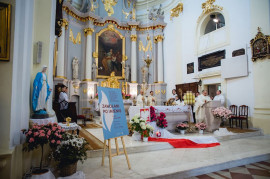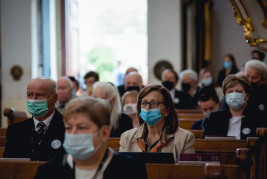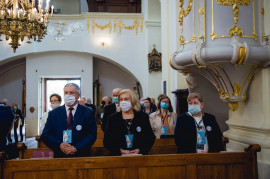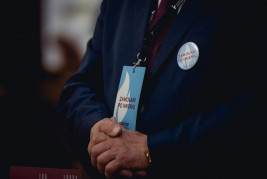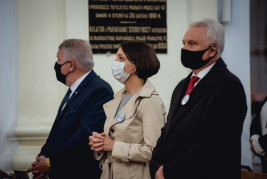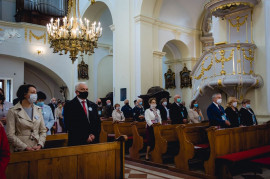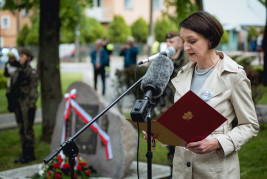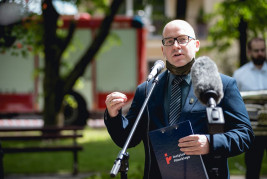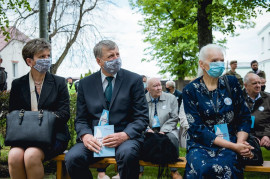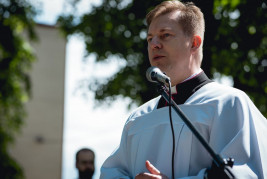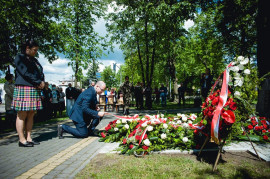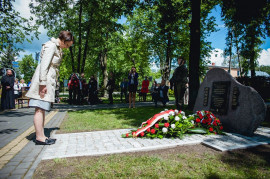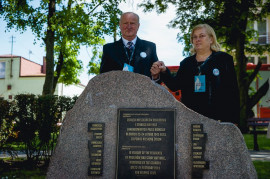A commemoration of the eleven Poles murdered in Paulinów - Instytut Pileckiego
A commemoration of the eleven Poles murdered in Paulinów
Eleven Poles murdered for saving Jews during the war were commemorated by the Pilecki Institute on Thursday, 4 June, in Sterdyń. This was the tenth stone with a commemorative plaque unveiled as part of the project, which began in March 2019.
Antoś did not understand why he had only two grandparents, while his friends had as many as four. After all, that’s twice as much fun, twice as many hugs, and sweet rolls. Sometimes he asked his dad about what had happened to his parents. Then he noticed that his father’s usually serene face changed; “Not now, don’t bother me,” he said. Curiosity, however, was stronger. So when aunt Stasia came to visit, and dad locked himself in the room with her, the boy would “pace” by the door. And he listened. He managed to pick out single words from the conversation, but he only learned the full truth several years later.
Today, Antoni Kotowski remembers it this way: “Under communism, you couldn’t say a word about it. When we were going to school, it wasn’t as if anyone helped. Nobody was interested in that. I think the authorities swept it all under the carpet, so as not to start a fire.”
Ewa and Józef Kotowski, Antoni’s grandparents, and Stanisław, his uncle, were killed on the night of 23 February 1943 during a German-led roundup in Paulinów. Eight people from Paulinów and Stary Ratyniec died with them: Franciszek Kierylak, Stanisław Piwko, Zygmunt Drgas, Marian Nowicki, Zygmunt Uziębło, Franciszek Augustyniak, Jan Siwiński and Aleksandra Wiktorzak. They all helped Jews hiding in the nearby forest who had escaped from the liquidated ghetto.
On 4 June 2020, the Pilecki Institute commemorated these “silent, local heroes, unknown to the general public” in Sterdyń. The ceremony, held under the honorary patronage of Prime Minister Mateusz Morawiecki, was attended by representatives of central and local authorities and the local community. Special guests included family members of the commemorated individuals. Due to the pandemic, the event was not open to the general public.
The commemoration of the residents of Paulinów and Stary Ratyniec as part of the “Called by Name” project began with a Holy Mass celebrated by Rev. Dr. Piotr Sawczuk, Bishop of the Diocese of Drohiczyn.
During the ceremony, Hanna and Antoni Kotowski (Antoni is the grandson of the murdered Ewa and Józef, and the nephew of Stanisław) said: “Our memory reaches far and is very painful, especially for our closest family. It was our ancestors who behaved in a way that showed us how to find a human being within another (...). Years have passed, but our hearts have not forgotten. Thanks to your commitment, the memory and story of our family will go down in the annals of history even more strongly, and this monument will remind the residents of the noble hearts of our ancestors.”
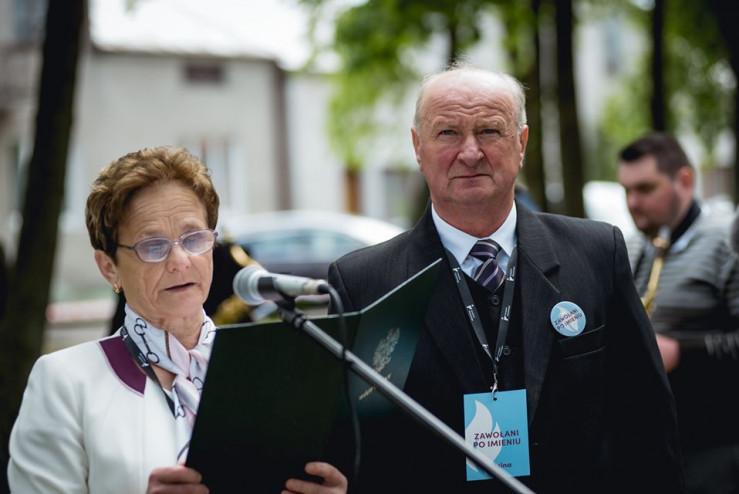
During the unveiling of the memorial plaque on the square at Tadeusz Kościuszko Street, a letter from Prime Minister Morawiecki was read by Prof. Magdalena Gawin, Deputy Minister of Culture and National Heritage. In the letter, Prime Minister Morawiecki mentioned the names of eleven quiet local heroes unknown to the general public: “The actions of the residents of Paulinów and Stary Ratyniec, but also of thousands of nameless Polish heroes who provided assistance to persecuted Jews, calls us to cherish historical truth and to do everything possible to record the often unknown examples of the nobility and bravery of Poles in the general historical consciousness. I believe that we will continue this mission”. In his letter, Prime Minister Morawiecki thanked everyone for their commitment, work and activity, which made it possible to carry out this task. Minister Gawin also thanked the families of the victims who cherish the memory of their ancestors, and called on local teachers to familiarize students with the fate of their local heroes.
The story commemorated in Sterdyń is an example of the generosity of a group of ordinary people who, despite the threat of capital punishment, did not hesitate to help their Jewish neighbors. We discuss the details of this event in our podcast entitled “Czego nie widać w Paulinowie?” (you can listen to it in Polish here). The story also shows the brutality and ruthlessness of the German occupiers, ready to engage large forces to terrorize and punish those who had the courage to disobey the racist policies of the Third Reich.
“On the night of 23 February 1943, in Paulinów and the surrounding area, the Germans conducted a raid on Jews in hiding who had escaped from the liquidated ghetto in nearby Sterdyń”, said Dr. Marcin Panecki, a researcher at the Pilecki Institute. “Those actions were a part of a larger campaign involving about 2,000 soldiers and policemen, which made it possible to tightly surround the village. According to witness testimonies, Ernst Gramss – the German district governor of Sokołów-Węgrów who was known for his cruelty – personally took part in the operation. Within the framework of these activities, retaliation was also taken against people who rescued the fugitive Jews.”
Thanks to the residents of Paulinów and Stary Ratyniec some of the escapees from the ghetto found shelter in the nearby forest. A few, with the consent of Franciszek Kierylak, a stable boy and a caretaker at the local manor, stayed overnight in the manor buildings. Some of them were acquaintances from before the war: Aron, a butcher by profession; Ankiel, an elderly shoemaker; 15-year-old Szymel Ruskielenke and his brother Szlojme, a barber and Czesław Kotowski’s classmate. The fugitives were provided with food and various kinds of support: they were given straw to insulate their hiding places and were allowed to stay temporarily in farm buildings.
In order to identify people helping Jews, the Germans used a man claiming to be a fugitive from a transport to Treblinka, who joined the Jews in hiding. He observed and noted down who was helping. A slice of bread was enough to be added to the “list”. During the roundup operation he pointed out “guilty” Poles to the Germans.
As a result, 11 people from Paulinów and Stary Ratyniec were killed. First the Germans murdered Franciszek Kierylak, who was dragged out of the barn and shot in front of his house. Then Ewa and Józef Kotowski were killed on the threshold of their own house. Their daughter Stanisława, who witnessed the execution, and their son Czesław, miraculously escaped death. The Kotowskis’ older son, Stanisław was hounded into a nearby distillery along with Stanisław Piwko. They were soon joined by the others: Zygmunt Drgas, Marian Nowicki and Zygmunt Uziębło. The five were led to a nearby forest and shot. The Germans murdered Franciszek Augustyniak, Jan Siwiński and Aleksandra Wiktorzak at a local brickyard.
The murdered Poles were buried in the forest near the road. After the war, the families of the victims exhumed the bodies and buried them in local cemeteries. The fate of the rescued Jews remains unknown. According to witnesses, one Jewish fugitive and two escaped Soviet prisoners of war, who also received help from the local population, were killed in the executions in the Paulinów forest.
